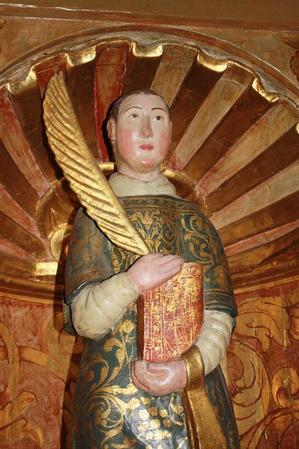A Deacon Exorcist and Martyr

The image depicts a 16th century wood polychrome statue of a smiling Saint Cyriacus. Note the lovely green dalmatic and golden maniple he is wearing.
Saint Cyriacus
As one of the great deacon martyrs of the Church, alongside of Saint Stephen, Saint Lawrence, and Saint Vincent of Saragossa, Saint Cyriacus deserves to be better known. Cyriacus was a Roman nobleman who, after accepting the Gospel of Christ and receiving Holy Baptism, renounced his considerable wealth, and gave it away to the poor. Ordained a deacon of the Church of Rome, Cyriacus served under Popes Saints Marcellinus and Marcellus (296-309). At the time, deacons played a vital role in the life of the Church, being wholly occupied in preaching, in sacramental and liturgical ministrations, and in the care of the poor and sick.
Servant of the Poor and Exorcist
The deacon Cyriacus became famous for the conversions to the faith that he brought about, for the healing of the sick, and the liberation of souls in the grip of the powers of darkness. All Rome spoke of the zeal of Cyriacus, of his charity, and the power of his prayer. During the time the Emperor Diocletian was building his famous baths, Cyriacus ministered as an angel of mercy and an envoy of the love of Christ among the enslaved prisoners there condemned to forced labour.
Deliverances and Conversions
When Artemesia, Diocletian’s daughter fell ill, he was told that Cyriacus alone would be able to heal her. Diocletian freed Cyriacus and begged him to heal his daughter. Cyriacus prayed, chased from Artemesia the demon that was afflicting her, and so restored her to health. As a result, Artemesia asked for Holy Baptism, and Diocletian gave Cyriacus a house in Rome.
Word of the prodigy reached Persia, where Jobias, the daughter of King Shapur II was suffering from the same kind of demonic affliction. Diocletian and his wife Serena decided, then, to send Cyriacus to Persia. There, true to his charism, he liberated Jobias. This miraculous healing caused the entire family of King Shapur II to ask for Holy Baptism. King Shapur, in an effort to keep Cyriacus in Persia, offered him great wealth. Cyriacus, however, after fasting for forty-five days, returned to Rome.
Martyrdom
In 303, together with other Christians of Rome, including Saints Largus and Smaragdus, who refused to participate in idolstrous practices, he was tortured and beheaded under the reign of Maximian. His body in rests in the church of Santa Maria in Via Lata near the Piazza Venezia, and in the abbey of Altorf in Alsace. In 1994, by disposition of Camillo Cardinal Ruini, Vicar of Rome, a vial of the holy martyr’s blood was given to the sanctuary of Torre le Nocelle, where it is the object of fervent veneration.
Cultus
Saint Cyriacus is venerated as one of the Fourteen Holy Helpers; his feast is kept on 8 August. He is a patron saint of deacons and of exorcists and, even today, obtains by his intercession, the deliverance of souls from harassment by evil spirits.
Prayer to Saint Cyriacus
O glorious Saint Cyriacus,
thou whom, for thy outstanding zeal and compassion,
Pope Saint Marcellinus raised to the dignity of the diaconate
in the Church of Rome,
and who, with intrepid patience,
didst endure the dislocation of thy members,
the laceration of thy flesh,
the torture of boiling water and,
finally, death itself by beheading,
look upon us who invoke thee,
and obtain for us the grace to remain steadfast in the faith,
in spite of the temptations of the Evil One,
and to live in such union with Christ Jesus
as to merit the blessedness of eternity in HIs presence.
O excellent martyr of Christ,
honoured today in all the world,
let us experience the power of thy arm.
Show us thy mercy, even as thou hast shown it in times past,
and grant us the favour we desire. Amen.
Glory be to the Father three times.
